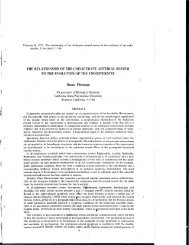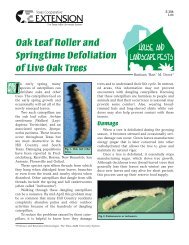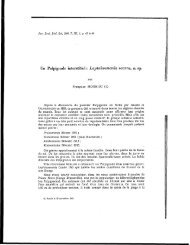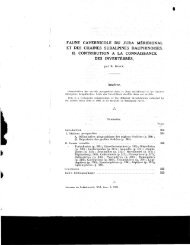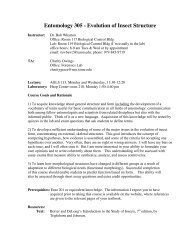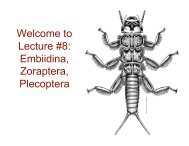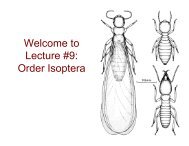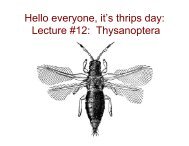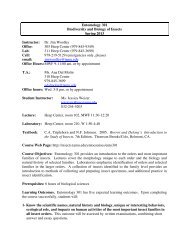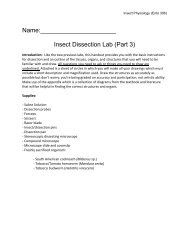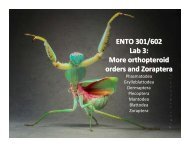Lab 3: Insect Mouthparts
Lab 3: Insect Mouthparts
Lab 3: Insect Mouthparts
Create successful ePaper yourself
Turn your PDF publications into a flip-book with our unique Google optimized e-Paper software.
<strong>Lab</strong> 3: <strong>Insect</strong> <strong>Mouthparts</strong>
Types of <strong>Mouthparts</strong><br />
Type As seen in…<br />
Chewing Grasshoppers, crickets<br />
Chewing & Sucking Honeybee<br />
Sucking Butterflies and Moths<br />
Piercing-sucking Bugs, fleas, mosquitoes, stable flies<br />
Piercing-sucking & sponging Horse flies<br />
Sponging House and blow flies
labium<br />
maxilla<br />
mandible<br />
labrum
Grasshopper <strong>Mouthparts</strong>
• <strong>Lab</strong>rum: flaplike<br />
Chewing <strong>Mouthparts</strong><br />
• Mandibles: incisor &<br />
molar regions<br />
(Clissold, 2007)
• Maxillae<br />
– cardo<br />
Chewing <strong>Mouthparts</strong><br />
– stipes (with palps)<br />
– galea (lateral lobe) & lacinia<br />
(mesal lobe; with teeth)
• <strong>Lab</strong>ium<br />
– postmentum<br />
– prementum<br />
• palps<br />
Chewing <strong>Mouthparts</strong><br />
• glossae (median) &<br />
paraglossae (lateral); or<br />
ligula if lobes are fused<br />
• Hypopharynx-<br />
tongue-like floor of mouth<br />
postmentum<br />
prementum<br />
palp<br />
pg<br />
Image of roach<br />
labium by Jack Scott<br />
submentum<br />
mentum<br />
g
The Honey bee:<br />
Chewing & Sucking <strong>Mouthparts</strong><br />
• Chewing mandibles<br />
• <strong>Lab</strong>ium and maxillae modified for<br />
nectar feeding<br />
paraglossae<br />
F<br />
http://www.extension.org/pages/21758/head-segment-of-the-honey-bee<br />
galea
Carpenter Bee <strong>Mouthparts</strong>
Lepidoptera:<br />
Sucking <strong>Mouthparts</strong><br />
• Proboscis formed<br />
from galea (of<br />
maxillae)<br />
• <strong>Lab</strong>ial palps evident<br />
(fun fact- Saturniidae without<br />
mouthparts as adults)
Hemiptera:<br />
Piercing-sucking <strong>Mouthparts</strong><br />
• 4 stylets<br />
– 2 mandibles<br />
– 2 maxillae<br />
• <strong>Lab</strong>ial and maxillary<br />
palps absent<br />
http://www.daviddarling.info/encyclopedia/H/Hemiptera.html
Agriculture and Agri-Food Canada<br />
image by Doug Bray, Roby Butt
Fleas:<br />
Piercing-sucking <strong>Mouthparts</strong><br />
• 3 stylets that enter<br />
host<br />
– 2 maxillary<br />
(laciniae)<br />
– 1 epipharynx<br />
• Maxillary palps<br />
and labial palps do<br />
not enter host
Center for Disease Control Archive<br />
epi<br />
http://www.nhm.ac.uk/
Dragonfly naiad
• Honeybee<br />
http://www.youtube.com/watch?v=-<br />
_cXqda1BZA<br />
• Dragonfly naiad<br />
http://www.youtube.com/watch?v=SJiwcRt<br />
-gQw



